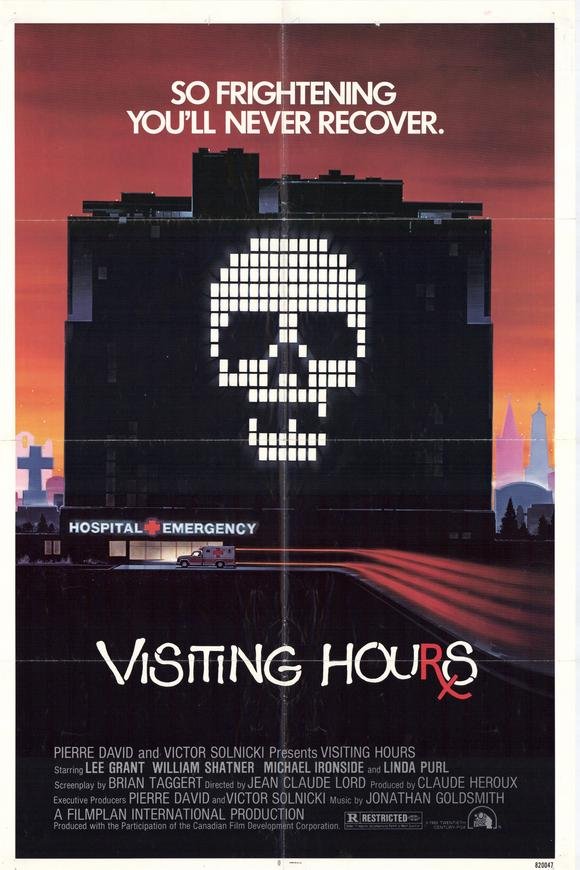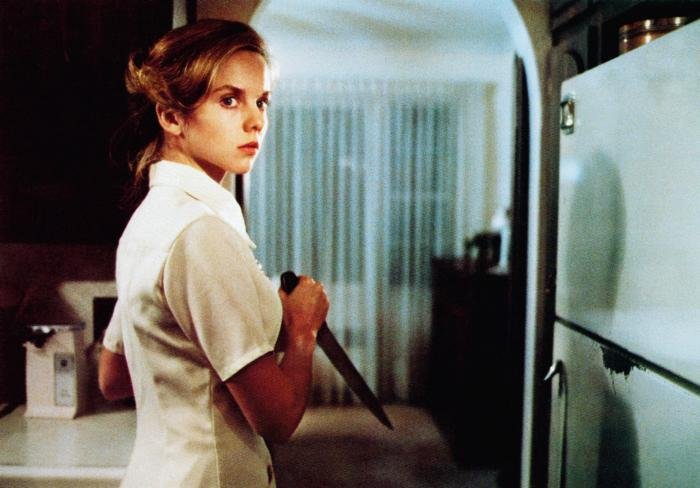VISITING HOURS: A Slasher Movie For Grown Ups?
The core elements of the slasher movie were quickly established between the successes of Halloween and Friday The 13th: youthful cast, plenty of kills, a faceless psycho, a little skin. It's as stripped down as the mechanics of a narrative film can get, which is the slasher genre had such an intense appeal for younger viewers. As a result, the slasher movie quickly became known in the eyes of critics and genre aesthetes as sleazy kid stuff, simple stuff for simple young minds. Once this image was stuck in place, it was rare for filmmakers to try and bend the rules. After all, these films weren't made for critics - and why take  the risk of toying with a proven, successful film formula?However, there were a few rule-breakers. The most memorable is probably Visiting Hours, a fascinating anomaly that follows the genre's suspense mechanics while completely disregarding most of its core elements. In this film, the heroine is a middle-aged woman: Deborah Ballin (Lee Grant) is a t.v. commentator who is using her show to campaign on behalf of a woman who has been imprisoned for killing her abusive husband in self-defense. Her public critique angers Colt Hawker (Michael Ironside), a quiet but menacing "Travis Bickle" type who harbors intense animosity towards women.Colt attacks Deborah in her home after the show but she alerts the neighbors before he can finish the job. Deborah is quickly whisked away to the local hospital, where she is watched over by dutiful head nurse Sheila (Linda Purl) and her t.v. station boss Gary (William Shatner). Unfortunately for everyone, Colt is far from finished with his task. He begins plotting ways to get at Deborah - and he won't stop at anything to silence her forever, including menacing any other women who gets between him and his target.
the risk of toying with a proven, successful film formula?However, there were a few rule-breakers. The most memorable is probably Visiting Hours, a fascinating anomaly that follows the genre's suspense mechanics while completely disregarding most of its core elements. In this film, the heroine is a middle-aged woman: Deborah Ballin (Lee Grant) is a t.v. commentator who is using her show to campaign on behalf of a woman who has been imprisoned for killing her abusive husband in self-defense. Her public critique angers Colt Hawker (Michael Ironside), a quiet but menacing "Travis Bickle" type who harbors intense animosity towards women.Colt attacks Deborah in her home after the show but she alerts the neighbors before he can finish the job. Deborah is quickly whisked away to the local hospital, where she is watched over by dutiful head nurse Sheila (Linda Purl) and her t.v. station boss Gary (William Shatner). Unfortunately for everyone, Colt is far from finished with his task. He begins plotting ways to get at Deborah - and he won't stop at anything to silence her forever, including menacing any other women who gets between him and his target. Visiting Hours has never been a popular entry in the slasher genre. There could be a few reasons for this. The most obvious is that it arrived on U.S. movie screens at a time when fatigue with the genre had kicked in (1982). It also suffered from misinterpretation by mainstream critics, who erroneously labeled it as a misogynist film because of its uncompromising portrayal of the villain's brutality. The latter charge is a real head-scratcher because the film is actually quite sympathetic towards its female characters, all of whom are portrayed as more thoughtful/resourceful than the men in the film, and espouses a feminist mindset through the main character of Deborah.
Visiting Hours has never been a popular entry in the slasher genre. There could be a few reasons for this. The most obvious is that it arrived on U.S. movie screens at a time when fatigue with the genre had kicked in (1982). It also suffered from misinterpretation by mainstream critics, who erroneously labeled it as a misogynist film because of its uncompromising portrayal of the villain's brutality. The latter charge is a real head-scratcher because the film is actually quite sympathetic towards its female characters, all of whom are portrayed as more thoughtful/resourceful than the men in the film, and espouses a feminist mindset through the main character of Deborah. This bad reputation is a shame because Visiting Hours actually represents a more mature, evolved version of the genre. Brian Taggert's script breaks the expected rules by setting it in a world of adults who deal with real-life concerns between the suspense setpieces. It also takes a surprising amount of time to dimensionalize its characters: in addition to the film's exploration of Deborah's social views, it also allows Sheila to functions as a second lead by giving the audience insight into how her personal life informs her choices at work. Even more interesting is the portrayal of Colt, who is given a backstory that explains his misogynistic impulses in a distinctly Freudian way.
This bad reputation is a shame because Visiting Hours actually represents a more mature, evolved version of the genre. Brian Taggert's script breaks the expected rules by setting it in a world of adults who deal with real-life concerns between the suspense setpieces. It also takes a surprising amount of time to dimensionalize its characters: in addition to the film's exploration of Deborah's social views, it also allows Sheila to functions as a second lead by giving the audience insight into how her personal life informs her choices at work. Even more interesting is the portrayal of Colt, who is given a backstory that explains his misogynistic impulses in a distinctly Freudian way. That said, horror fans need not worry that Visiting Hours is all character portraits and editorializing. It is well-paced despite its generous 105-minute running time, with director Jean-Claude Lord maintaining tension via a series of skillfully staged cat-and-mouse setpieces (he also co-edited the film). The film further benefits from effective cinematography by Rene Verzier, an ace Canadian cameraman who also photographed cult faves like Rabid and The Little Girl Who Lives Down The Lane. He creates an effective blend of gliding dolly shots and creepy hand-held camera work to build tension and uses the sterile confines of the hospital to atmospheric effect.
That said, horror fans need not worry that Visiting Hours is all character portraits and editorializing. It is well-paced despite its generous 105-minute running time, with director Jean-Claude Lord maintaining tension via a series of skillfully staged cat-and-mouse setpieces (he also co-edited the film). The film further benefits from effective cinematography by Rene Verzier, an ace Canadian cameraman who also photographed cult faves like Rabid and The Little Girl Who Lives Down The Lane. He creates an effective blend of gliding dolly shots and creepy hand-held camera work to build tension and uses the sterile confines of the hospital to atmospheric effect. Most importantly, Visiting Hours benefits from strong performances to back up its unusually nuanced characterizations. Grant is one of the most unique Final Girls in slasher history, creating a smart, worldly heroine who has the big personality to back up her opinions. She gets a little hammy in places, the funniest bit being her reaction to an unwanted sedative, but it suits the character well. Purl creates an interesting contrast as her nurse friend, underplaying in a quiet manner to create a second heroine goes about her tasks with a quiet intelligence.
Most importantly, Visiting Hours benefits from strong performances to back up its unusually nuanced characterizations. Grant is one of the most unique Final Girls in slasher history, creating a smart, worldly heroine who has the big personality to back up her opinions. She gets a little hammy in places, the funniest bit being her reaction to an unwanted sedative, but it suits the character well. Purl creates an interesting contrast as her nurse friend, underplaying in a quiet manner to create a second heroine goes about her tasks with a quiet intelligence. However, it is Ironside who really impresses as the film's psycho: he speaks few lines but uses his physicality and expressive face to create an emotionally complex portrait of a sociopath with a minimum of dialogue. It's some of his best work, right up there with his turn as Darryl Revok in Scanners. Elsewhere, William Shatner fans will be amused by his work in this film: his character is a background type designed to nudge the exposition along but he has a nice chemistry with Grant and is shockingly subtle here.In short, Visiting Hours is one of the most underrated entries in the early 1980's slasher cycle, a film that will surprise horror fans with its sense of craft and unusually thoughtful approach to what is often deemed a disposable subgenre of the horror film. It's also the best of the hospital-themed slashers, a highly specialized corner of the slasher film that also includes Halloween II and Hospital Massacre. It definitely deserves a better reputation. Even grown-ups might get into a slasher flick like this.
However, it is Ironside who really impresses as the film's psycho: he speaks few lines but uses his physicality and expressive face to create an emotionally complex portrait of a sociopath with a minimum of dialogue. It's some of his best work, right up there with his turn as Darryl Revok in Scanners. Elsewhere, William Shatner fans will be amused by his work in this film: his character is a background type designed to nudge the exposition along but he has a nice chemistry with Grant and is shockingly subtle here.In short, Visiting Hours is one of the most underrated entries in the early 1980's slasher cycle, a film that will surprise horror fans with its sense of craft and unusually thoughtful approach to what is often deemed a disposable subgenre of the horror film. It's also the best of the hospital-themed slashers, a highly specialized corner of the slasher film that also includes Halloween II and Hospital Massacre. It definitely deserves a better reputation. Even grown-ups might get into a slasher flick like this.


